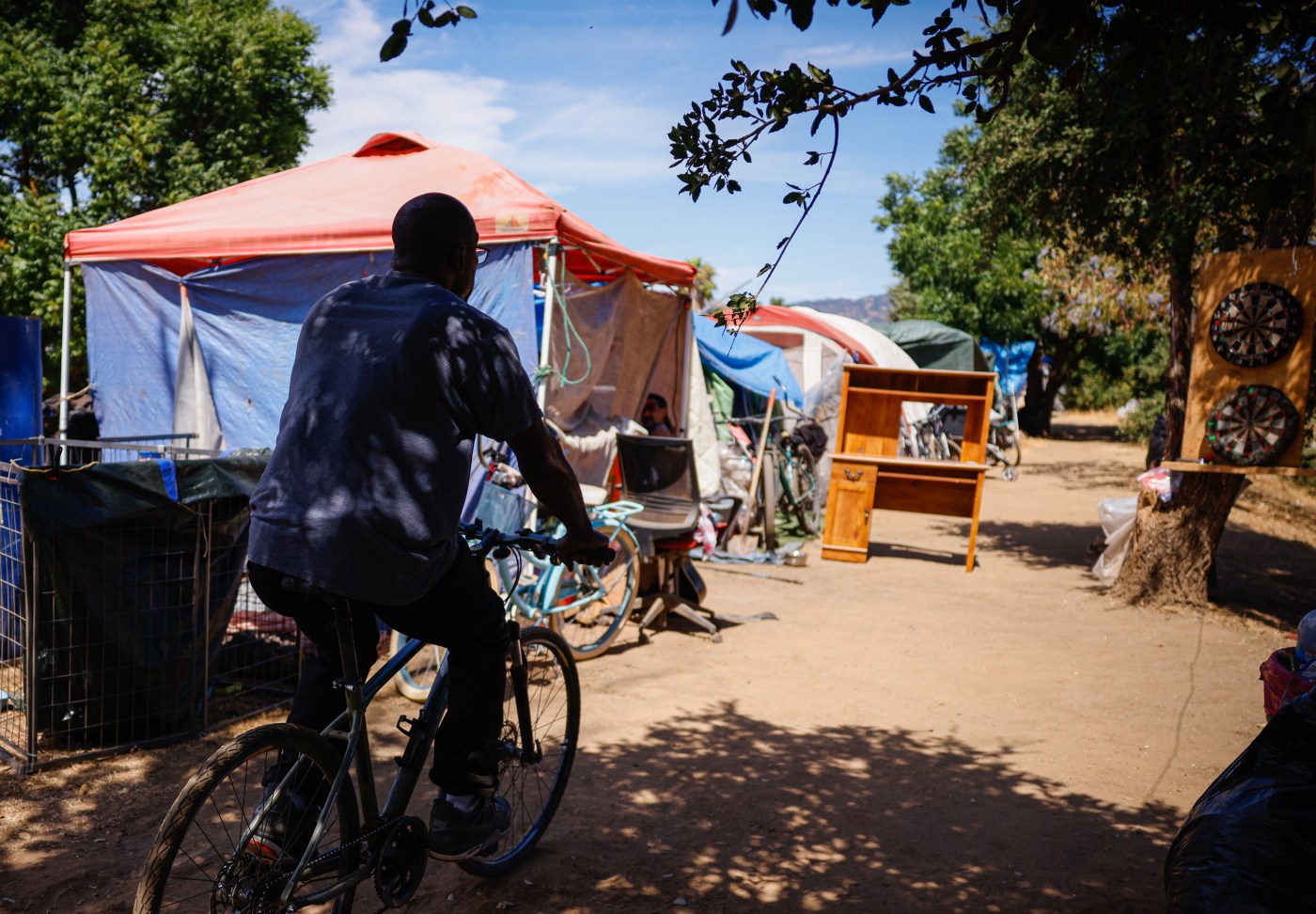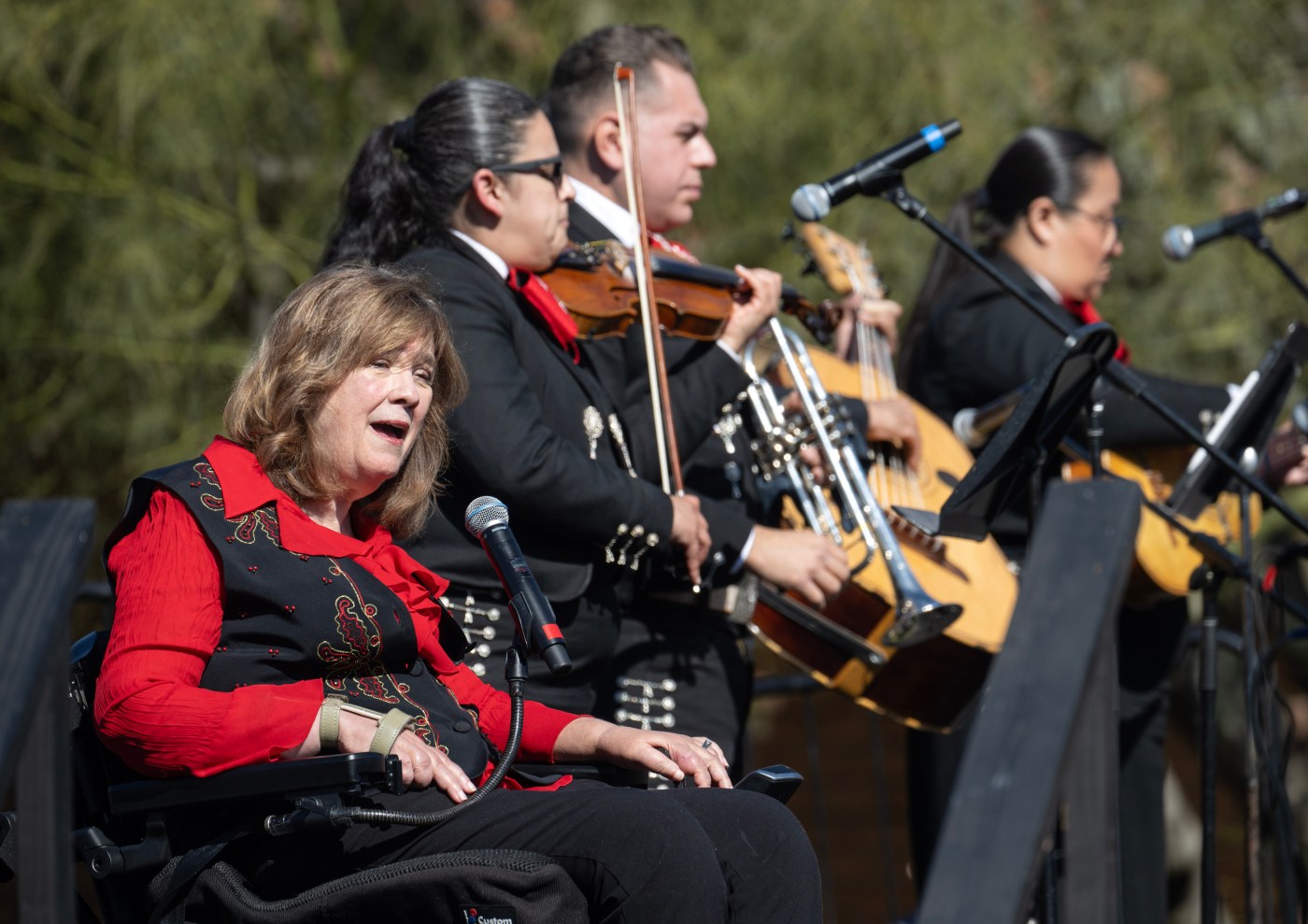At the southernmost edge of the Bay Area, Gilroy sits nestled between the tree-covered Santa Cruz Mountains and the rolling golden hills of the Diablo Range. The city of some 60,000 people is surrounded by fields and orchards, and on summer nights the smell of garlic hangs in the air — reminders of its deep agricultural roots and its world-famous festival.
But behind that agrarian beauty lies a sobering statistic: Gilroy has one of the largest homeless populations in the entire region.
While it trails cities many times its size, when measured proportionally, the direness of Gilroy’s homelessness plight becomes clear. It has more than 17 unhoused residents per thousand residents, according to a Mercury News analysis of available California Department of Finance and county data. That is more than Oakland, nearly double that of San Francisco and more than twice that of San Jose.
Gilroy confronts many of the economic and social challenges around homelessness familiar to communities throughout the Bay Area, yet it does so with only a fraction of the resources, an analysis of city resources and demographics found.
Tim Davis, the executive director of the Gilroy nonprofit South County Community Services, during one of their weekly “Unhoused Popup Markets” where those in need can receive food, services and support in Gilroy on Tuesday, Aug. 19, 2025. (Shae Hammond/Bay Area News Group)
“We’ve got the worst situation in the county and the least amount of financial support for it,” said Tim Davis, the executive director of the Gilroy nonprofit South County Community Services. “That’s the biggest problem.”
From farming hub to Silicon Valley’s ‘bedroom’
Located near the southern end of Santa Clara Valley, Gilroy was for decades one of the most significant agricultural hubs in the state, becoming a prolific producer of prunes and, famously, garlic, and hosting fruit and vegetable canneries. Together, these industries employed much of Gilroy’s population throughout the early to mid-20th century and attracted a diverse group of immigrant laborers, including those from Italy and Mexico.
“People who worked in the cannery used to be able to buy a house … people who worked the land could make a living and pay rent,” said Susan Voss, manager of the Gilroy Museum, which catalogs historical records and artifacts of the city. But toward the latter half of the 20th century, that began to change.
As canning and agriculture waned, Silicon Valley kick-started a technological boom to the north. Many took advantage of the relatively low cost of living in Gilroy: In the 70s, the median monthly rent was $93, compared to $134 in San Jose. (That’s $794 and $1,145 in today’s dollars.) Residents, advocates and city leaders point to that influx of better-paid workers, saying it drove up housing prices in Gilroy, and several recount anecdotes of their families being pushed out to the Central Valley by the rising cost of rent.
While most of the Bay Area has seen housing prices double since 1970, when adjusted for inflation, housing prices in Gilroy went up more than two-and-a-half times, according to an analysis of housing data from 1970 to 2021 by the data-tracking initiative Vital Signs.
A drone photo of neighborhoods at the base of the mountains in Gilroy Aug. 13, 2025. Gilroy’s population has grown over 40% since the turn of the century.(Shae Hammond/Bay Area News Group)
“All these changes, particularly in the later half of the 20th century, they’re all reflected in this town,” Voss said.
Even as housing costs rose, Gilroy remained one of the most affordable cities in Silicon Valley, with median rent at $2,137, according to the most recent census data in 2023. The lower housing costs have solidified this place as a housing hub for both white-collar Silicon Valley workers and those who provide the web of services that support them. According to census data from 2022, more than four out of every five Gilroy workers commute.
Traffic on 101 in Morgan Hill during the afternoon commute late last year. According to census data from 2022, over four out of every five Gilroy workers commute. (Shae Hammond/Bay Area News Group)
This imbalance between jobs and housing has led to its own host of problems, including taxes that aren’t keeping up with expenses, leaving Gilroy without many of the resources bolstering the rest of the county. Gilroy faces a slate of issues that can make life more difficult for those who live in the southern part of Santa Clara County. It has one of the lowest median incomes in Silicon Valley, faces issues with reduced access to public transit, less access to medical and emergency services, limited access to jobs, and limited funding for its city services.
Gilroy’s issues with homelessness have worsened in recent years, but they are not new: Since 2009, homeless counts have shown Gilroy to have among the highest rates of homelessness in the Bay Area. While the city lacks most of the large, visible encampments of cities to the north, there are spread-out clusters of tents tucked beneath trees and unhoused residents sleeping in RVs and cars parked throughout the city, often abutting private property.
The tension between unhoused and housed Gilroyans is a constant source of friction in the city, flaring up at City Council meetings, on online forums, and in opinion columns in the local newspaper. There, anxiety over trash, fires, drug use, crime and public safety often mixes with concern for the human suffering that homelessness represents.
“The city’s at risk and the homeless are at risk, damage to property and theft is increasing, public safety is decreasing,” said resident Ron Gurries at a City Council meeting last year, echoing common concerns among residents. “We need action now.“
A homeless encampment sits next to a railroad track in Gilroy on Wednesday, Feb. 7, 2024. (Dai Sugano/Bay Area News Group)
Many locals argue that this increase in homelessness stems from those who come to Gilroy after losing their housing, drawn by more outreach and resources. However, county data and interviews with service providers suggest that most of the unhoused served in Gilroy are from Gilroy or Morgan Hill, and in-depth interviews with a dozen unhoused people showed that nine lived in Gilroy or Morgan Hill — in many cases, for decades — prior to losing their housing. Still, there were a few exceptions: One resident interviewed came from Hollister because he heard Gilroy’s shelter had better food; another who had formerly lived in Gilroy came from San Jose because it was more peaceful; another immigrated to Gilroy because her sister lives here. So while there is some influx of unhoused people from elsewhere contributing to the unhoused count, that cannot by itself explain homelessness in Gilroy.
As in much of the rest of the nation, many in Gilroy have struggled with issues of drug addiction. While most unhoused people in California do not regularly use drugs, drug use factored into the homelessness of multiple people interviewed by this news organization, at times to tragic effect.
Angelica, 37, near the encampment where she lives in Gilroy on Saturday, Aug. 9, 2025. Being undocumented complicates Angelica’s situation; however, she is applying for housing and hopes to improve her issues with mental health and addiction. (Shae Hammond/Bay Area News Group)
Angelica, who asked that her last name not be used because she’s in the country illegally, first tried methamphetamine when a former boyfriend offered it to her, saying it would help her stay alert. Sleep-deprived from working two jobs, she took it. Soon, she became addicted, and that addiction changed her life. Seven years ago, she discovered a relative had sexually abused one of her daughters, and when Child Protective Services investigated the family, Gomez tested positive for drugs and could not stay with her children.
“I helped out my mother a lot, paid rent, worked two jobs. But they took my girls, and that’s when nothing mattered to me anymore,” she said in Spanish.
Angelica, who is homeless, holds one of her cats near the encampment where she lives in Gilroy. She says caring for her cats is like therapy amid the struggles of the streets.(Shae Hammond/Bay Area News Group)
For a while, Angelica says, she spiraled, losing her housing, falling deeper into addiction and stealing to get what she needed. These days, she says, she no longer steals and, along with her boyfriend, recycles and gathers objects that others throw away to get by.
AUDIO: Angelica shares her thoughts about searching for hope amid troubles in her encampment and struggles with mental health.
https://www.mercurynews.com/wp-content/uploads/2025/08/Angelica_final.mp3
Angelica’s situation is further complicated due to her immigration status. Of the dozen unhoused residents interviewed by this news organization, three were in the country without permission. Without legal status, such immigrants generally cannot access federal aid such as housing vouchers or food stamps, and often take less stable, lower-wage jobs, making it more difficult for them to afford housing. Multiple service providers in Gilroy noted that many they serve are in the country illegally, potentially exacerbating Gilroy’s already thorny homelessness problem.
Angelica, right, hugs her daughter Baleria (who did not want her last name used) at an encampment in Gilroy on Wednesday, Aug. 20, 2025. Though her eldest daughter will visit her, Angelica says she rarely has contact with her two younger daughters. (Shae Hammond/Bay Area News Group)
A striking lack of resources
An analysis of data comparing Gilroy to other cities in the Bay Area — along with over a dozen interviews with service providers, former and current city leaders, advocates and nonprofit workers — underscored an unfortunate truth: Gilroy has only a fraction of the resources as major cities with high homelessness.
The city of Gilroy spends between $1 million and $2 million — less than 1% of its budget — a year on housing and homelessness services, not including money spent on encampment cleanups.
An encampment can be seen nestled under trees along a fenceline bordering private property in Gilroy on Wednesday, Aug. 20, 2025. Tensions sometimes spring up between nearby property owners and those who live in the encampment. (Shae Hammond/Bay Area News Group
Gilroy’s relatively small city budget for homelessness has been largely dedicated to staffing two positions in its Housing and Community Services division and two Quality of Life Officers — police officers primarily dedicated to interacting with unhoused residents and responding to complaints involving them.
Beyond staffing, the city relies on federal and county money to fund homelessness aid and homelessness prevention. Over the past decades, budgets for housing and homelessness have shrunk at the state and federal level, leaving smaller communities like Gilroy especially vulnerable, said Jennifer Loving, CEO of housing nonprofit Destination Home. Loving contends this national context is essential to understanding homelessness statewide and locally.
“It doesn’t mean that every city can’t make the best choices possible with the resources that they have in isolation, it’s just a lot of nibbling and not a lot of big bites,” Loving said. “It’s a failure at every level.”
While several nonprofits in Gilroy are dedicated to helping those without housing, they lack the funding that might help them serve the unhoused. According to a United Way Bay Area analysis, Gilroy receives only 0.1% of the philanthropic donations in the county despite being one of the ZIP codes with the highest needs for aid.
A shortage of shelter and housing
Unhoused resident Armando Villarreal Jr., whose fiancée Kelly Tasker died in 2021 while homeless, touches a handmade tombstone for her during a memorial event to mourn local homeless residents who died in 2023, on Thursday, Dec. 21, 2023, at Gilroy City Hall. (Dai Sugano/Bay Area News Group)
This gap goes beyond funding to the resources available to Gilroy residents once they lose their housing — from the number of shelter beds to the housing units that might help residents out of homelessness.
While both San Francisco and San Jose have about one shelter bed for every two unhoused people, Gilroy only has around one bed available year-round for every nine people who are unhoused, according to county data. A similar story plays out when looking at permanent supportive housing — units that provide affordable housing with support services. While San Jose has around five people who are unhoused for every unit of permanent supportive housing, Gilroy has over nine people who are unhoused for every unit.
In Gilroy and elsewhere, most of these housing units and shelter beds are currently occupied, meaning those on the street are often searching for housing, at times for months or years, waiting for availability.
After a city order to clear her encampment, Toni-Jo Napihaa packs up her camp along the banks of Uvas Creek in Gilroy in the fall of 2023. A 2023 Gilroy ordinance restricts camping in parks and by creeks. (Karl Mondon/Bay Area News Group)
That’s true for Toni-Jo Napihaa, 64, who, after she lost her housing in 2012, had a brief stint with homelessness and ended up living in a boyfriend’s RV. When she decided to leave what she called a “very, very toxic relationship,” she couldn’t find a bed at a domestic violence shelter and feared being tracked down by her ex at the group shelter, so she ended up pitching a tent in a park. Over the next decade, she continued working at San Jose Unified School District until she resigned in 2022, and continued to search for housing.
Napihaa was offered housing in San Jose, but her current partner works in Gilroy. Those who help connect unhoused people in Gilroy to housing say this is a frequent occurrence, and can place some in a dilemma: to get housed, they have to leave behind their community and support system.
After spending more than a year looking for housing in Gilroy, Toni-Jo Napihaa finally acquired an affordable apartment last March. (Shae Hammond/Bay Area News Group)
Luckily, Napihaa found housing in Gilroy in March 2024. At first, the change was disorienting. “It was like we’re waiting for the other shoe to drop,” Napihaa said. “I felt: ‘Is this true? Is this a fairytale?’” Now, she’s found ways to enjoy her new life: She plays at game nights with a local church group, practices Tai Chi at a local community center and recently celebrated 44 years of sobriety.
AUDIO: Napihaa’s reaction as she moves into her apartment and recalls how her life has changed.
https://www.mercurynews.com/wp-content/uploads/2025/08/TJ-final.mp3
To get more people like Napihaa into housing, those who work with unhoused people are consistent in their message: Gilroy — and the region as a whole — must build more housing, especially for those who are lowest on the income scale.
Nearly one in three Gilroy households is extremely or very low income — meaning they make less than half of the median income in the county, according to 2021 Housing and Urban Development data, but only 42 units of very low-income housing were built in Gilroy between 2018 and 2024, according to the California Department of Housing & Community Development. Over that same period, three of every four units built in Gilroy were designated “above moderate income.” Across the Bay Area, only 9.6% of housing built from 2018 to 2024 was very low-income. In Gilroy, that figure was 4.6%.
Gilroy Mayor Greg Bozzo notes that while more housing is needed, Gilroy is more affordable than most other Bay Area cities. He resents Gilroy being seen as the “bedroom of Silicon Valley,” and argues that the wealthiest communities in Silicon Valley have to “create some housing, so people who are cleaning your homes can live there.”
While most housing experts maintain that all communities in the Bay Area need to build more housing, many agree that those communities with more jobs must do more to house their workforce.
Is there a way forward for Gilroy?
Even so, Bozzo — elected late last year — admits that the city has failed to put staff in place to bring in enough resources for housing and homelessness from the state and the county. He hopes to take a regional, collaborative approach to addressing homelessness in Gilroy.
Gilroy Mayor Greg Bozzo speaks during a City Council meeting at Gilroy City Hall in Gilroy, Calif., on Monday, Aug. 18, 2025. (Nhat V. Meyer/Bay Area News Group)
“We limited our potential to deal with this very, very difficult and complex problem in a better way,” Bozzo said. He points to nearby Morgan Hill, which has an unhoused specialist, a position initially funded through a grant by Destination Home that is dedicated to direct outreach, case management, and connecting unhoused people to services.
At the county level, Santa Clara County is coordinating with the city to bring a new affordable housing project to Gilroy, and plans to bring a new substance abuse treatment facility this year and open an inpatient facility in 2026, where Gilroy residents could get overnight care.
“When I joined the Board in 2023, I found that far too little had been invested in resources to help South County families succeed,” said county Supervisor Sylvia Arenas, whose district includes Gilroy. “Gilroy is finally seeing some of the investment it deserves.”
As city and county officials decide how to move forward with a solution, the concerns of housed Gilroyans continue to grow, as many argue for stricter enforcement of those living on the streets in the face of perceived disorder.
Meanwhile, unhoused residents like Angelica will continue trying to survive. While Angelica has become accustomed to the rhythms of living on the streets, at only 37, she said she already feels aged by her time facing homelessness. She said she is applying for housing and hopes to improve her issues with mental health and addiction. “I want to get a little better so I can support my daughter,” she said in Spanish. “I want to get out.”
Angelica, 37, sits inside a tent at an encampment in Gilroy. Angelica says she already feels aged by her time facing homelessness. ÒI want to get out.Ó she said in Spanish.
(Shae Hammond/Bay Area News Group)
This article was produced as a project for the USC Annenberg Center for Health Journalism’s 2025 California Health Equity Fellowship and the Lori Yearwood Fund for Reporting on Homelessness.





